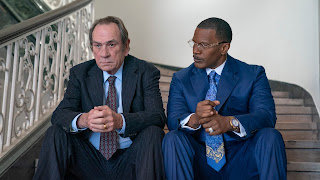Faith in Film, Week 6
Sometimes movies just get you. "The Shawshank Redemption," first released in 1994, is one of those movies. It's a movie that's nearly universally beloved, and might easily be the best film we're going to look at during this run together. And the reason for that is simple—though it's set in a prison, it's the most hopeful film we'll look at in this class together. And hope is something we all crave.
The story of how this film came to be is a fun one. A few weeks ago I noted that Darabont was a fan of Stephen King, and had originally sought to adapt The Mist as his directorial debut. Instead, he was given the opportunity to adapt this film. Darbont started his career making short films, as many do, as a way to get noticed and get a shot at directing feature films. The first film he wrote and directed was a short adaptation of Stephen King's The Woman in the Room, which made the semi-finalist list for Academy Award consideration in 1983. Although Darabont was not happy with how the short turned out, it led to a close association with King, who granted him the "handshake deal" rights to another one of his shorter works, Rita Hayworth and Shawshank Redemption. And still, Darabont almost didn’t make the film. Rob Reiner, who had previously adapted another King novella, The Body, into the movie Stand by Me offered Darabont $2.5 million in an attempt to write and direct Shawshank. He planned to cast Tom Cruise in the part of Andy and Harrison Ford as Red. Darabont seriously considered and liked Reiner's vision, but he ultimately decided it was his "chance to do something really great" by directing the film himself. I honestly can’t even imagine the Tom Cruise-Harrison Ford version of this film, and I’m grateful that didn’t happen.
Instead, Darabont finished the film himself, casting Tim Robbins in the part of Andy and Morgan Freeman in the part of Red. It was not a film that did well at the Box Office at the time, opening on September 25, 1994 with just $727,000. It made just $28 million during its Box Office run, but it’s a movie that was a huge hit with critics, and became beloved with all who saw it. In fact, it ended up being a major player at the Academy Awards that year. It was nominated for seven Academy Awards—Best Picture, Best Actor for Morgan Freeman, Best Adapted Screenplay, Best Sound, Best Editing, Best Score and Best Cinematography. And it didn’t win a single award. But 1994 was a killer year for films. The Best Picture field included Shawshank, Pulp Fiction, Four Weddings and a Funeral, Quiz Show and the winner, Forrest Gump. Freeman, likewise, lost to Tom Hanks. In fact, Forrest Gump dominated the awards, and The Lion King dominated the music categories.
But now 25 years later, The Shawshank Redemption is still the film that most talk about from that group. Janet Maslin, critic for the New York Times, called the film an impressive directorial debut that tells a gentle tale with a surprising amount of loving care. Roger Ebert placed it on his list of the Greatest Movies of All-Time, which is high praise he didn’t offer easily or lightly. But it’s not just critics that loved the film, but fans. It has been the number 1 film on IMDb's user-generated Top 250 since 2008, when it surpassed The Godfather, having remained at or near the top since the late 1990s. For those of you that don’t know, the IMDB list is generated from fan votes. And the fact it continues to be No. 1, and has been since 2008, is a testament to its greatness and what it means to those that have seen it.
King was also pleased about this adaptation. King said, “If that isn't the best [adaptation of my works], it's one of the two or three best, and certainly, in moviegoers' minds, it's probably the best because it generally rates at the top of these surveys they have of movies. ... I never expected anything to happen with it.”
And at the heart of this is a beautiful story of friendship between Andy and Red, one that is beautifully hopeful as well. That's what we'll look at Wednesday night.
Discussion Questions:
1. Did this movie work for you, why or why not?
2. In the film, Andy Dufresne manages to keep a hopeful outlook despite tough circumstances that landed him in prison. Why is his hopeful outlook so important to him, and what does it do for Red?
3. Red talks about hope being a dangerous thing, while Andy says that hope is a good thing, maybe the best thing. What does the Bible have to say about hope? Why do we need hope?




Comments
Post a Comment